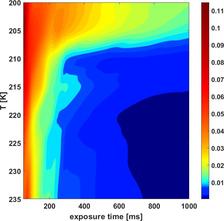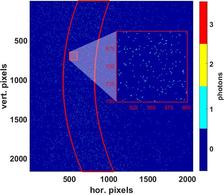Dynamics of the system at different temperatures. Below the glass transition temperature (T < 210 K) a 'frozen-in' component is visible at long exposure times. With increasing temperature the dynamics get faster as expected. (Credit: PRL /J. Verwohlt et al.)
A newly developed experimental method allows to study the dynamics of atoms and molecules at PETRA III with much lower radiation doses than previously possible. This opens the door for dynamical investigations of very radiation sensitive samples such as for example proteins in solution. The new method takes full advantage of the large number of pixels of modern X-ray detectors and the large coherent fraction of the X-rays produced by PETRA III to reconstruct the movement of the molecules using only a very limited number of photons. A German-Swedish team of scientists headed by the University Siegen has for the first time revealed the movement of nanostructures in ionic liquids at the glass transition. The results have been recently published in the journal Physical Review Letters.
The beamline P10 at the synchrotron source PETRA III at DESY provides extremely coherent X-ray light. The monochromatic electromagnetic waves propagate in phase and diffraction by the sample results in a complex speckle diffraction pattern due to interference effects. This speckle pattern is a map of the molecules inside the sample, hence any movement of the molecules results in a change of the pattern. With fast dynamics in the sample this movement also happens during a single exposure. The systematic investigation of these changes in dependence of the exposure time is called X-ray speckle visibility spectroscopy (XSVS) and allows a reconstruction of the molecular dynamics.
Other methods often require long exposure times which lead to significant radiation damage in soft matter samples. Proteins for example often only endure exposures of fractions of a second. For this reason the dynamics in such systems were previously inaccessible. In the new approach, images with short but varying exposure times are recorded. The acquired speckle patterns solely consist of 0, 1- and 2-photon events with only every 100th pixel showing a photon event at all. Thousands of these speckle patterns are recorded at different spots on the sample, which results in an equal spread of the radiation dose over the whole sample size and a minimized local beam damage. The dynamic information is now encoded in the ratio of 0-,1- and 2-photon events: For fast dynamics the number of 2-photon events decreases while the 1-photon events increase. Adding the different events depending on the according exposure times leads to the dynamic information of the sample.
This new approach has been used to investigate the dynamics of imidazolium based ionic liquids at the glass transition. Due to their electrochemical properties ionic liquids are interesting for applications for example in the energy sector as electrolytes in batteries and capacitors. Moreover they are interesting for fundamental research as they exhibit nanoscale structures in form of micelles. While the glass transition is often understood as the freezing of all movement, the experiments clearly showed that the nanoscale structures do not easily freeze but still exhibit movement on time scales of ms even at temperatures 10 degrees below the nominal transition temperature. The analysis of these processes contributes to a better understanding of the still mysterious liquids and glasses.
Furthermore the new XSVS approach is especially suitable for the investigation of dynamics in biological systems. The authors expect new insights into processes such as the aggregation of bio molecules to larger superstructures or biomineralization. This method will be even more important for the next generation of synchrotron sources such as PETRA IV, which will deliver even higher intensities of coherent X-ray photons.
Reference:
Low Dose X-Ray Speckle Visibility Spectroscopy Reveals Nanoscale Dynamics in Radiation Sensitive Ionic Liquids; Jan Verwohlt, Mario Reiser, Lisa Randolph, Aleksandar Matic, Luis Aguilera Medina, Anders Madsen, Michael Sprung, Alexey Zozulya, and Christian Gutt; Phys. Rev. Lett., 2018, DOI: 10.1103/PhysRevLett.120.168001








